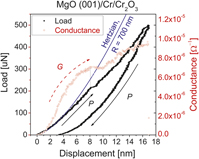Crossref Citations
This article has been cited by the following publications. This list is generated based on data provided by
Crossref.
Sprouster, D.J.
Ruffell, S.
Bradby, J.E.
Stauffer, D.D.
Major, R.C.
Warren, O.L.
and
Williams, J.S.
2014.
Quantitative electromechanical characterization of materials using conductive ceramic tips.
Acta Materialia,
Vol. 71,
Issue. ,
p.
153.
Tobiszewski, Mateusz Tomasz
Zieliński, Artur
and
Darowicki, Kazimierz
2014.
Dynamic Nanoimpedance Characterization of the Atomic Force Microscope Tip-Surface Contact.
Microscopy and Microanalysis,
Vol. 20,
Issue. 1,
p.
72.
Fujisawa, Naoki
Ogura, Tomo
and
Hirose, Akio
2016.
A Method for Studying the Nano-Scale Stress-Strain Response of a Material by Nanoindentation.
MATERIALS TRANSACTIONS,
Vol. 57,
Issue. 6,
p.
1006.
Sparks, G.
Phani, P. Sudharshan
Hangen, U.
and
Maaß, R.
2017.
Spatiotemporal slip dynamics during deformation of gold micro-crystals.
Acta Materialia,
Vol. 122,
Issue. ,
p.
109.
Mercier, David
Mandrillon, Vincent
Parry, Guillaume
Verdier, Marc
Estevez, Rafael
Bréchet, Yves
and
Maindron, Tony
2017.
Investigation of the fracture of very thin amorphous alumina film during spherical nanoindentation.
Thin Solid Films,
Vol. 638,
Issue. ,
p.
34.
Saleem, Muhammad Amin
Shafiee, Sareh
Qiu, Anqi
and
Desmaris, Vincent
2018.
Direct Electrical and Mechanical Characterization of Carbon Nanofibers Turf Using a Probe Card and Nanoindentation.
p.
1.
Comby-Dassonneville, S.
Charlot, F.
Martin, R.
Roussel-Dherbey, F.
Maniguet, L.
Pellerin, D.
Volpi, F.
Boujrouf, C.
Parry, G.
Braccini, M.
Iruela, S.
Antoni-Zdziobeka, A.
Champion, Y.
and
Verdier, M.
2019.
Development and Application of a Multifunctional Nanoindenter: Coupling to Electrical Measurements and Integration In-Situ in a Scanning Electron Microscope.
p.
1.
Comby-Dassonneville, Solène
Volpi, Fabien
Parry, Guillaume
Pellerin, Didier
and
Verdier, Marc
2019.
Resistive-nanoindentation: contact area monitoring by real-time electrical contact resistance measurement.
MRS Communications,
Vol. 9,
Issue. 3,
p.
1008.
Volpi, F.
Boujrouf, C.
Rusinowicz, M.
Comby-Dassonneville, S.
Mercier, F.
Boichot, R.
Chubarov, M.
Germanicus, R. Coq
Charlot, F.
Braccini, M.
Parry, G.
Pellerin, D.
and
Verdier, M.
2021.
Development of a multifunctional nanoindenter integrated in-situ Scanning Electron Microscope - application to the monitoring of piezoresponse and electro-mechanical failures.
Thin Solid Films,
Vol. 735,
Issue. ,
p.
138891.
Ohmura, Takahito
and
Wakeda, Masato
2021.
Pop-In Phenomenon as a Fundamental Plasticity Probed by Nanoindentation Technique.
Materials,
Vol. 14,
Issue. 8,
p.
1879.
George, Jeena
Mannepalli, Sowjanya
and
Mangalampalli, Kiran S. R. N.
2021.
Understanding Nanoscale Plasticity by Quantitative In Situ Conductive Nanoindentation.
Advanced Engineering Materials,
Vol. 23,
Issue. 9,
Volpi, Fabien
Rusinowicz, Morgan
Comby-Dassonneville, Solène
Parry, Guillaume
Boujrouf, Chaymaa
Braccini, Muriel
Pellerin, Didier
and
Verdier, Marc
2021.
Resistive-nanoindentation on gold: Experiments and modeling of the electrical contact resistance.
Review of Scientific Instruments,
Vol. 92,
Issue. 3,
Kim, Kangsik
Son, Seungwoo
Lee, Seonwoo
Ahn, Jong-Hyun
and
Lee, Zonghoon
2022.
Observation of the Initial Stage of 3C-SiC Heteroepitaxial Growth on the Si Nanomembrane.
Crystal Growth & Design,
Vol. 22,
Issue. 2,
p.
1421.
Luu, Hoang-Thien
Raumel, Selina
Dencker, Folke
Wurz, Marc
and
Merkert, Nina
2022.
Nanoindentation in alumina coated Al: Molecular dynamics simulations and experiments.
Surface and Coatings Technology,
Vol. 437,
Issue. ,
p.
128342.
Budiman, Arief Suriadi
2022.
Principles of Extreme Mechanics (XM) in Design for Reliability (DfR).
p.
63.
Mockute, Aurelija
Kostka, Aleksander
Abdellaoui, Lamya
Krysiak, Olga
Schuhmann, Wolfgang
Scheu, Christina
and
Ludwig, Alfred
2024.
Structural and Hydrogen Evolution Electrocatalysis Properties of Cr–Al–B MAB Phase Thin Films.
Advanced Engineering Materials,
Vol. 26,
Issue. 23,
